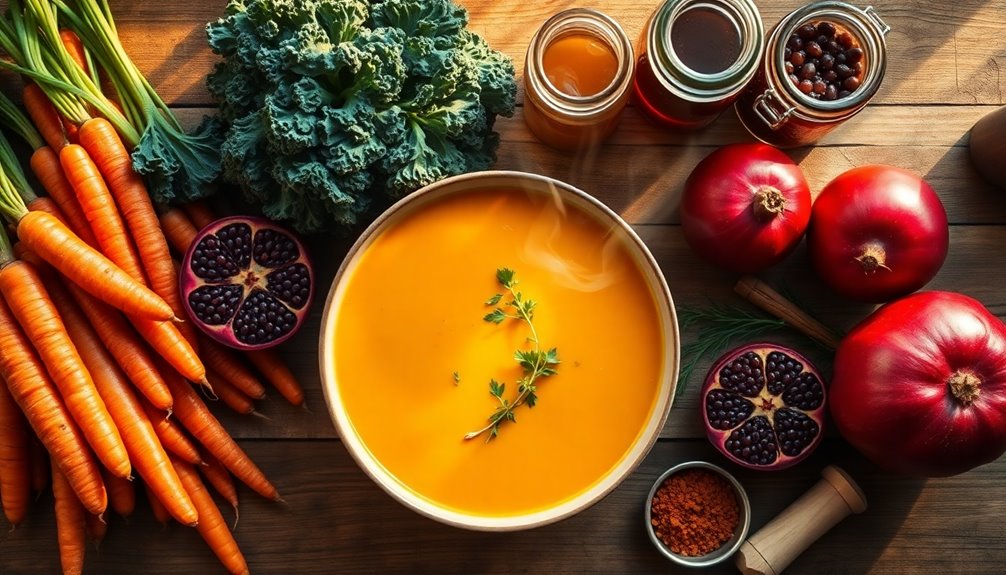To plan meals around winter's seasonal ingredients, start by focusing on tasty root vegetables like carrots and sweet potatoes, and hearty greens like kale. These ingredients are not just fresh but also packed with nutrients. Create a weekly menu that incorporates similar items to cut down on waste. Don't forget about winter fruits like citrus, which add brightness to your dishes. Utilize simple recipes like roasted vegetables or warming soups made in a slow cooker. Remember to store your produce properly to maintain freshness. There's so much more to explore in seasonal cooking to elevate your winter meals.
Key Takeaways
- Start by researching winter vegetables and fruits, such as root vegetables, kale, and citrus, to incorporate into your meals.
- Create a weekly menu featuring similar seasonal ingredients to reduce waste and simplify meal prep.
- Shop at local farmers' markets to find fresh, seasonal produce while supporting local agriculture.
- Plan meals that utilize proper storage techniques to maintain the freshness of ingredients, like using damp paper towels for leafy greens.
- Explore quick recipes, such as roasted root vegetables and slow cooker soups, to make satisfying winter meals effortlessly.
Understanding Seasonal Ingredients
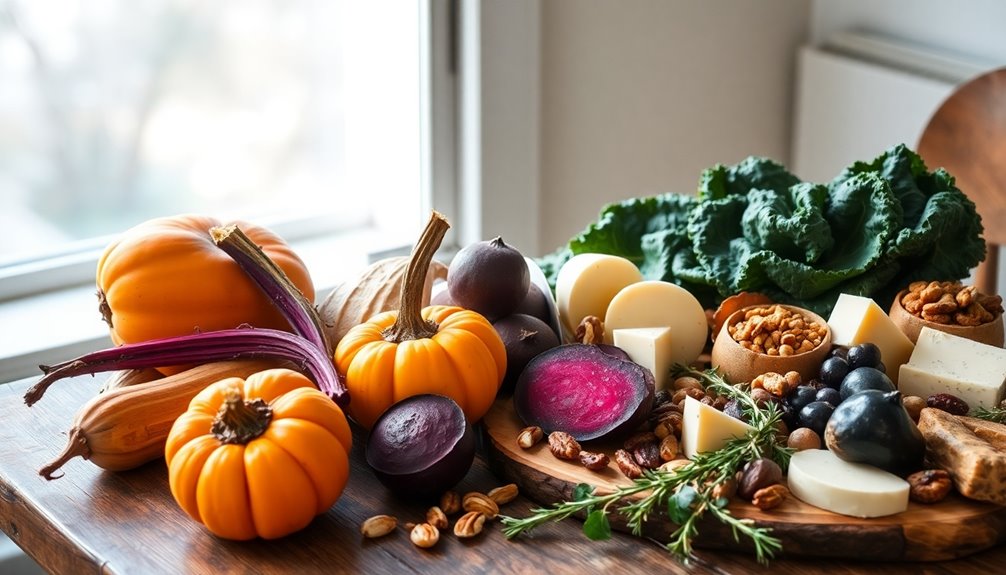
Understanding seasonal ingredients can transform your winter meals into a celebration of flavor and nutrition. When you embrace seasonal produce, you're not just cooking; you're connecting to the earth's rhythms and bringing warmth to your kitchen. Imagine the vibrant colors and textures of winter vegetables, each one waiting to inspire your next dish.
As winter settles in, you can find a rich variety of ingredients that are at their peak, ready to shine in your cooking. Think hearty root vegetables like carrots, parsnips, and sweet potatoes, which not only satisfy but also pack a nutritional punch. When you incorporate these seasonal gems, you're not only enhancing the taste of your meals but also supporting local farmers and reducing your carbon footprint. Additionally, embracing seasonal ingredients allows you to create meals that are rich in antioxidants and fiber, which are essential for overall health.
Culinary inspiration can bloom from this knowledge. Picture roasting a medley of seasonal produce, drizzled with olive oil and sprinkled with herbs. The warm, earthy aromas will fill your home, inviting loved ones to gather around the table.
You'll discover that cooking with seasonal ingredients can lead to creative combinations and delightful new recipes, sparking joy and connection.
Engaging with seasonal ingredients is about more than just what's on your plate; it's about fostering a sense of belonging within your community. So, next time you plan your meals, explore the seasonal offerings available. You'll find that cooking with what's in season not only nourishes your body but also feeds your soul.
Key Winter Vegetables
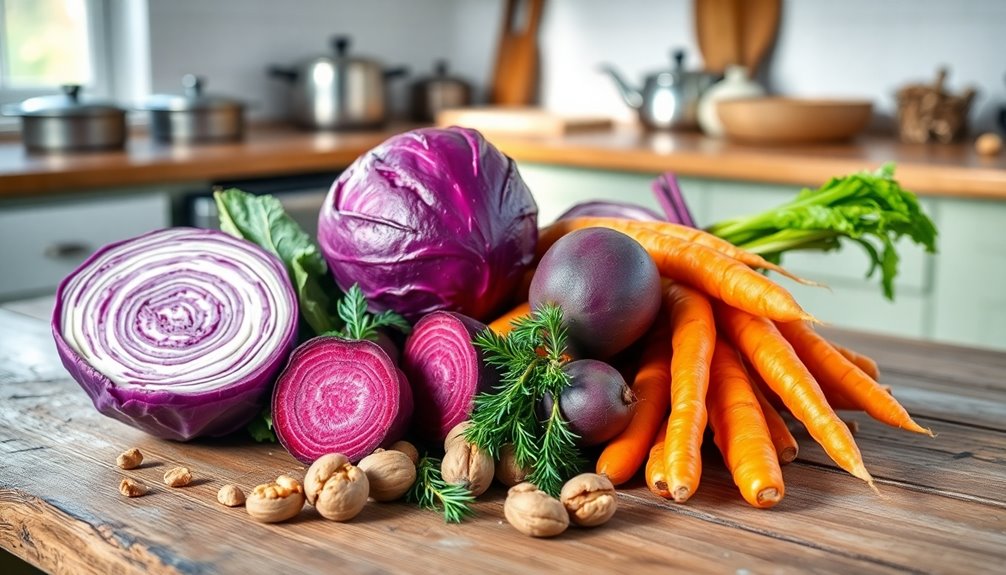
Winter's bounty is brimming with key vegetables that can elevate your meals and warm your soul. As the chill sets in, you'll find comfort in the robust flavors of root vegetables and hearty greens. These ingredients not only nourish your body but also create a sense of belonging as you gather around the table with loved ones.
Root vegetables like carrots, sweet potatoes, and parsnips are versatile and satisfying. Roasting them brings out their natural sweetness, making them a delightful side dish or a hearty addition to salads. Pair them with savory herbs for an earthy flavor that complements winter's ambiance.
Hearty greens, such as kale and collard greens, are perfect for crafting warming soups. They're packed with nutrients, ensuring you stay healthy through the cold months. Combine them with your favorite legumes and spices to create a comforting bowl that invites warmth into your home. Additionally, incorporating healthy recipes into your meal planning can enhance your dietary experience.
Here's a quick guide to these key winter vegetables:
| Vegetable | Best Uses |
|---|---|
| Root Vegetables | Roasting, Stews, Salads |
| Hearty Greens | Soups, Stir-fries |
Let these seasonal ingredients inspire your cooking this winter. By incorporating root vegetables and hearty greens into your meals, you'll not only create delicious dishes but also foster a sense of community and warmth during this cozy season. Enjoy the flavors of winter, and savor the moments spent around the table!
Flavorful Winter Fruits
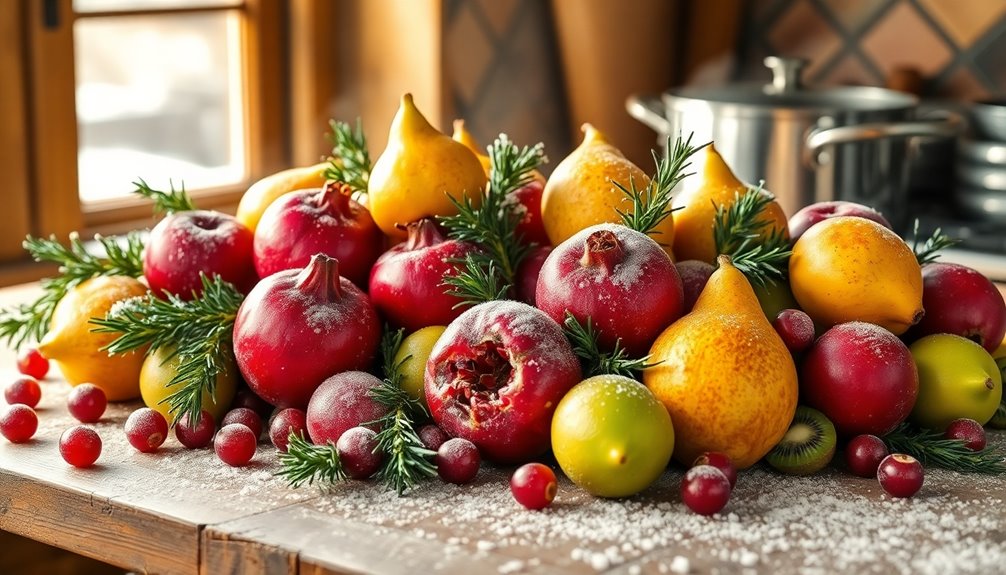
A delightful assortment of winter fruits can add invigorating flavors and essential nutrients to your meals during the colder months. When you think of winter fruits, winter citrus like oranges, grapefruits, and lemons often come to mind. These fruits aren't just invigorating; they're packed with vitamin C, helping to boost your immune system while brightening up your dishes.
Imagine starting your day with a zesty citrus salad or drizzling fresh lemon juice over roasted vegetables for an energizing twist.
Then there are apples, which shine even brighter during the winter. They're perfect for baking, offering a warm, comforting flavor that evokes cozy memories. Baking with apples can transform your kitchen into a haven of invigorating aromas.
Try whipping up a classic apple pie or a spiced apple crisp to share with loved ones. You'll find that the sweetness of the apples blends beautifully with cinnamon and nutmeg, creating a dish that's sure to bring everyone together.
Don't forget about pomegranates, either. Their jewel-like seeds add a burst of color and a invigorating crunch to salads or desserts. When planning your meals, think about how these fruits can enhance not only the flavors but also the overall experience of your meals. Additionally, incorporating protein-packed vegan smoothies can provide an energy boost and help you stay satisfied throughout the winter months.
Meal Planning Strategies
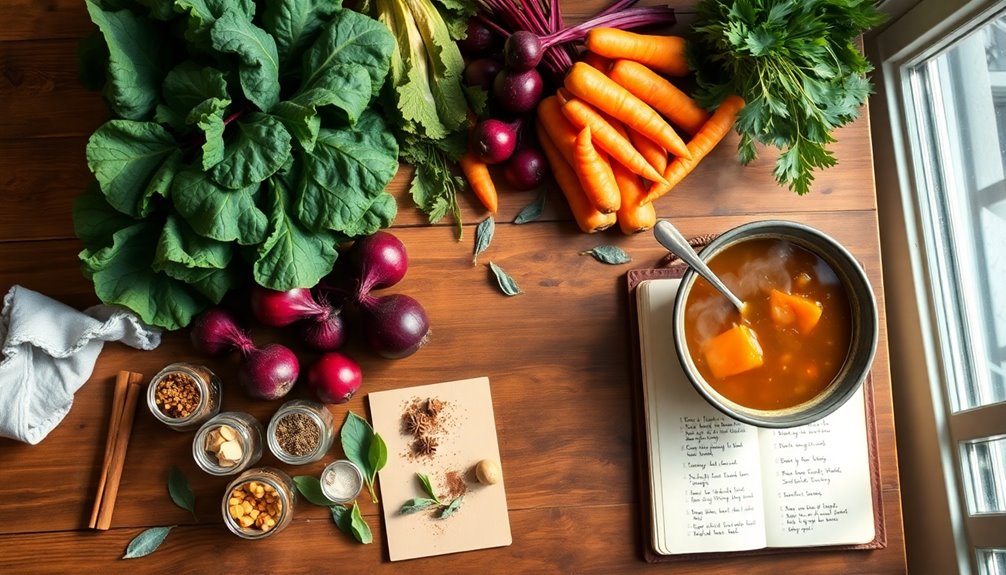
Effective meal planning can transform your winter cooking experience, making it easier and more enjoyable to create nourishing dishes. Start by gathering recipe inspiration that highlights seasonal ingredients like root vegetables, hearty greens, and citrus fruits. Browse cookbooks, food blogs, or social media platforms for ideas that resonate with your taste and lifestyle. You'll find a treasure trove of comforting soups, stews, and roasted dishes perfect for those chilly evenings.
Next, create a weekly menu based on your inspiration. Choose a few recipes that use similar ingredients to minimize waste and maximize flavor. For instance, if you buy a bunch of kale, plan to use it in salads, soups, and as a side dish throughout the week. This approach not only saves you time but also helps you feel more connected to the ingredients you're using.
When it comes to shopping, keep these shopping tips in mind:
- Make a list based on your meal plan, and consider shopping at local farmers' markets or co-ops for fresh, seasonal produce. These venues often have better quality and prices than traditional grocery stores.
- Don't hesitate to ask vendors for recommendations on how to prepare their ingredients, as they can provide valuable insights and tips. Additionally, understanding natural calorie cycles can help you make healthier choices that align with seasonal eating.
Simple Seasonal Recipes
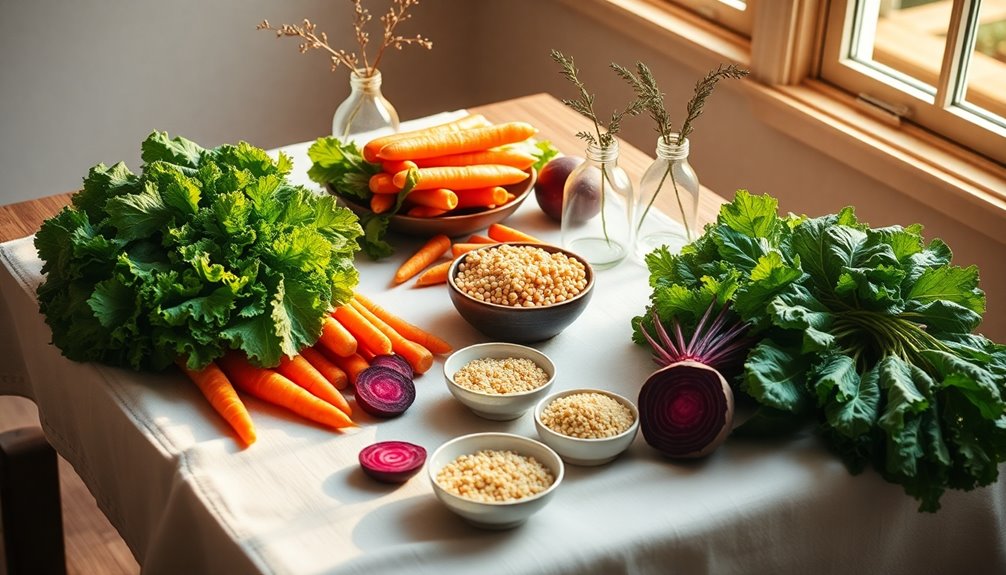
With a well-planned menu in hand, it's time to bring those seasonal ingredients to life with simple, delicious recipes. Winter's bounty offers a rich palette of flavors, perfect for both quick weeknight dinners and warm, comforting slow cooker soups.
Let's start with a quick weeknight dinner that's sure to impress. Try roasted root vegetables tossed with olive oil, salt, and your favorite herbs. Carrots, parsnips, and sweet potatoes roast beautifully and can be served alongside baked chicken or fish for a hearty meal in under 30 minutes.
For those cozy nights when you want to let the flavors meld together, a slow cooker soup is your best friend. Imagine a creamy butternut squash soup simmering with garlic, onions, and a touch of ginger. Just throw everything into your slow cooker in the morning, and by dinner, you'll have a velvety soup that warms both body and soul.
Another delightful option is a hearty lentil soup, made with seasonal kale and diced tomatoes. Not only is it nutritious, but it also fills your home with a comforting aroma. Additionally, incorporating fresh fruits and greens into your meals can enhance your diet and contribute to improved health over time.
These recipes aren't just about satisfying hunger; they're about gathering around the table with loved ones. So, roll up your sleeves, embrace the season, and enjoy the process of cooking with ingredients that celebrate winter. The joy of sharing these meals creates a sense of belonging, reminding us of the warmth that comes from both food and family.
Tips for Freshness and Storage
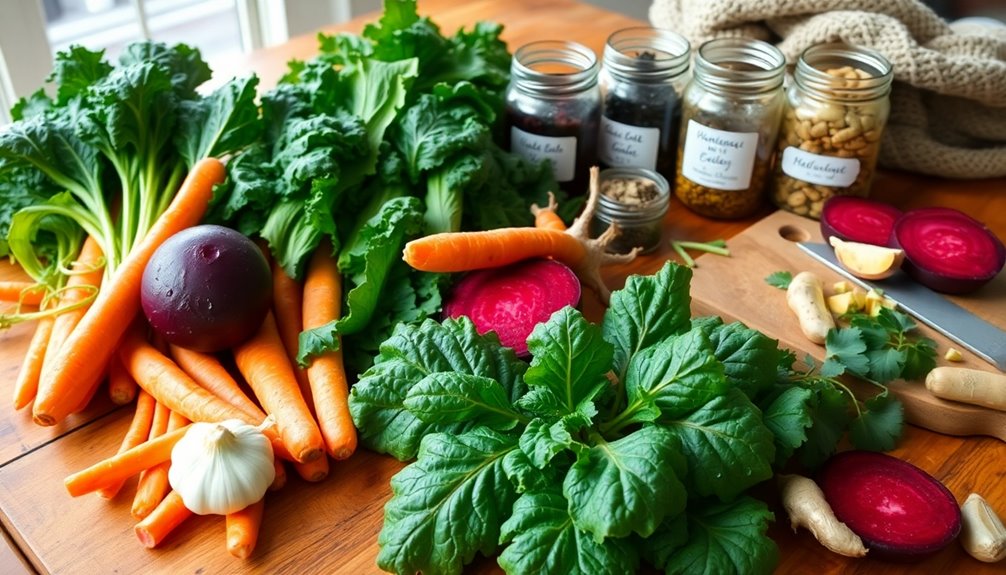
To keep your winter produce fresh and flavorful, understanding how to store it correctly is vital. Proper storage can make all the difference in maintaining freshness and ensuring your meals pop with seasonal goodness. Start by inspecting your fruits and veggies before bringing them home. Look for any bruises or blemishes, as these can lead to quicker spoilage.
For root vegetables like carrots and potatoes, a cool, dark place is your best bet. Store them in perforated bags or baskets to allow airflow, preventing moisture buildup.
Leafy greens, on the other hand, thrive in the fridge. Wrap them in a damp paper towel and place them in a breathable container to keep them crisp and vibrant.
When it comes to fruits like apples and pears, keep them separate from other produce. They emit ethylene gas, which can hasten ripening and spoilage. Instead, store them in a cool area or the crisper drawer of your fridge.
Don't forget to check your stored items regularly. Toss any that show signs of decay to prevent them from affecting the others. By practicing these simple tips for proper storage, you'll keep your winter produce fresh longer, making it easier to create heartwarming meals that bring everyone together. Embrace these habits, and let the seasonal ingredients shine in your kitchen!
Supporting Local Farmers
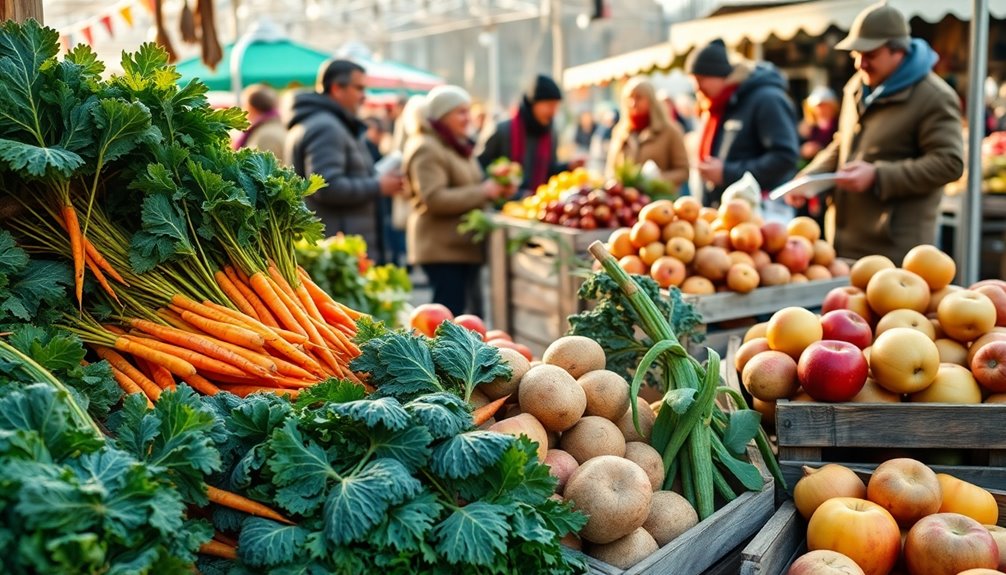
Finding fresh, seasonal ingredients is easier when you support local farmers. By establishing strong farmer relationships, you not only get access to vibrant produce but also contribute to the very heartbeat of your community. When you buy directly from local farms, you're investing in the people who grow your food, creating a network of community support that helps everyone thrive.
Sustainable sourcing plays an essential role here. Local farmers often use eco-friendly practices, which notably reduce the environmental impact of your food choices. When you choose to shop at farmers' markets or join a CSA (Community Supported Agriculture), you're not just filling your pantry; you're also making choices that support biodiversity and the local ecosystem.
You'll find that those fresh carrots, kale, and winter squash taste even better when you know they were grown just down the road. Additionally, building these connections gives you a sense of belonging. You'll get to know the faces behind your food, hear their stories, and understand the hard work that goes into every crop. This connection deepens your appreciation for the ingredients you cook with and the meals you share. Furthermore, many local farmers are aware of the health benefits of nutritional practices that help in managing conditions like diabetes, making your seasonal meals even more beneficial.
Frequently Asked Questions
How Do I Choose Between Organic and Conventional Seasonal Produce?
When choosing between organic and conventional seasonal produce, consider your budget and taste preferences. Organic often boasts richer flavors and health benefits, while conventional options can be more budget-friendly. Think about the environmental impact, too; organic farming typically promotes biodiversity and reduces chemical runoff. Ultimately, it's about what matters most to you.
Embrace the joy of selecting fresh ingredients that align with your values and enhance your meals this season.
What Are Some Easy Meal Prep Ideas for Winter Ingredients?
When the chill sets in, you crave warm, comforting meals that don't take hours to prepare. Imagine tossing veggies and protein into a slow cooker, letting the flavors meld while you go about your day.
Or picture a sheet pan meal, where everything roasts to perfection, creating a delightful aroma that fills your home.
These easy meal prep ideas not only save time but also keep you cozy and connected during winter's embrace.
Can I Freeze Seasonal Vegetables for Later Use?
Absolutely, you can freeze seasonal vegetables for later use! To guarantee proper storage, wash and chop them before blanching briefly in boiling water. This step helps maintain their color and nutrients. After cooling, pack them in airtight containers or freezer bags, removing as much air as possible. Label them with dates for easy tracking. Following these freezing tips will let you enjoy those seasonal flavors long after winter's gone, bringing warmth to your meals anytime!
How Can I Incorporate Winter Ingredients Into Snacks?
Imagine a cozy cabin filled with the warmth of a crackling fire, where winter's bounty transforms into delightful snacks.
You can whip up winter ingredient smoothies, blending kale, frozen berries, and a splash of almond milk for an invigorating treat.
Or, try roasted winter veggie bites, tossing cubed butternut squash and Brussels sprouts in olive oil and spices.
These snacks not only nourish you but also celebrate the season's flavors, bringing everyone closer together.
Are There Any Dietary Restrictions to Consider With Winter Produce?
When considering winter produce, it's important to think about allergies and personal preferences. Some seasonal ingredients might trigger reactions, so always check labels or ask about sourcing. You'll also want to make sure your meals meet your nutritional needs, balancing flavors and health. Availability can vary, so stay flexible and explore local markets. By being mindful of these factors, you create meals that not only nourish but also bring a sense of community and belonging.
Conclusion
As you embrace winter's bounty, remember that cooking with seasonal ingredients not only enhances your meals but also supports your local farmers. By incorporating vibrant vegetables and fruits into your meal planning, you'll keep your dishes fresh and exciting. So, don't just go through the motions—make the most of what winter has to offer! With a little creativity and seasonal flair, you'll be cooking up a storm and enjoying every bite along the way.

